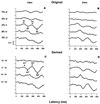Infant cortical electrophysiology and perception of vowel contrasts
- PMID: 24933411
- PMCID: PMC4265317
- DOI: 10.1016/j.ijpsycho.2014.06.002
Infant cortical electrophysiology and perception of vowel contrasts
Abstract
Cortical auditory evoked potentials (CAEPs) were obtained for vowel tokens presented in an oddball stimulus paradigm. Perceptual measures of vowel discrimination were obtained using a visually-reinforced head-turn paradigm. The hypothesis was that CAEP latencies and amplitudes would differ as a function of vowel type and be correlated with perceptual performance. Twenty normally hearing infants aged 4-12 months were evaluated. CAEP component amplitudes and latencies were measured in response to the standard, frequent token /a/ and for infrequent, deviant tokens /i/, /o/ and /u/, presented at rates of 1 and 2 tokens/s. The perceptual task required infants to make a behavioral response for trials that contained two different vowel tokens, and ignore those in which the tokens were the same. CAEP amplitudes were larger in response to the deviant tokens, when compared to the control condition in which /a/ served as both standard and deviant. This was also seen in waveforms derived by subtracting the response to standard /a/ from the responses to deviant tokens. CAEP component latencies in derived responses at 2/s also demonstrated some sensitivity to vowel contrast type. The average hit rate for the perceptual task was 68.5%, with a 25.7% false alarm rate. There were modest correlations of CAEP amplitudes and latencies with perceptual performance. The CAEP amplitude differences for vowel contrasts could be used as an indicator of the underlying neural capacity to encode spectro-temporal differences in vowel sounds. This technique holds promise for translation to clinical methods for evaluating speech perception.
Keywords: Auditory evoked potential; Infant; Speech perception.
Copyright © 2014 Elsevier B.V. All rights reserved.
Figures






Similar articles
-
Acoustic Change Complex and Visually Reinforced Infant Speech Discrimination Measures of Vowel Contrast Detection.Ear Hear. 2022 Mar/Apr;43(2):531-544. doi: 10.1097/AUD.0000000000001116. Ear Hear. 2022. PMID: 34456301 Free PMC article.
-
Dynamics of infant cortical auditory evoked potentials (CAEPs) for tone and speech tokens.Int J Pediatr Otorhinolaryngol. 2013 Jul;77(7):1162-73. doi: 10.1016/j.ijporl.2013.04.030. Epub 2013 May 27. Int J Pediatr Otorhinolaryngol. 2013. PMID: 23722003 Free PMC article.
-
Evidence of Vowel Discrimination Provided by the Acoustic Change Complex.Ear Hear. 2020 Jul/Aug;41(4):855-867. doi: 10.1097/AUD.0000000000000809. Ear Hear. 2020. PMID: 31688315
-
Varying effect of noise on sound onset and acoustic change evoked auditory cortical N1 responses evoked by a vowel-vowel stimulus.Int J Psychophysiol. 2020 Jun;152:36-43. doi: 10.1016/j.ijpsycho.2020.04.010. Epub 2020 Apr 14. Int J Psychophysiol. 2020. PMID: 32302643
-
Effect of Consonant Duration on Formation of Consonant-Vowel Syllable Evoked Auditory Cortical Potentials.J Int Adv Otol. 2018 Apr;14(1):39-43. doi: 10.5152/iao.2017.3389. Epub 2017 Nov 2. J Int Adv Otol. 2018. PMID: 29092801 Free PMC article.
Cited by
-
Speech token detection and discrimination in individual infants using functional near-infrared spectroscopy.Sci Rep. 2021 Dec 14;11(1):24006. doi: 10.1038/s41598-021-03595-z. Sci Rep. 2021. PMID: 34907273 Free PMC article. Clinical Trial.
-
Learning from the Longitudinal Outcomes of Children with Hearing Impairment (LOCHI) study: summary of 5-year findings and implications.Int J Audiol. 2018 May;57(sup2):S105-S111. doi: 10.1080/14992027.2017.1385865. Epub 2017 Oct 12. Int J Audiol. 2018. PMID: 29020839 Free PMC article.
-
Acoustic Change Complex and Visually Reinforced Infant Speech Discrimination Measures of Vowel Contrast Detection.Ear Hear. 2022 Mar/Apr;43(2):531-544. doi: 10.1097/AUD.0000000000001116. Ear Hear. 2022. PMID: 34456301 Free PMC article.
-
Neural detection of changes in amplitude rise time in infancy.Dev Cogn Neurosci. 2022 Apr;54:101075. doi: 10.1016/j.dcn.2022.101075. Epub 2022 Jan 20. Dev Cogn Neurosci. 2022. PMID: 35078120 Free PMC article.
-
The relationship between mismatch response and the acoustic change complex in normal hearing infants.Clin Neurophysiol. 2018 Jun;129(6):1148-1160. doi: 10.1016/j.clinph.2018.02.132. Epub 2018 Mar 16. Clin Neurophysiol. 2018. PMID: 29635099 Free PMC article.
References
-
- Berg KM. Auditory temporal summation in infants and adults: Effects of stimulus bandwidth and masking noise. Percept Psychophys. 1991;50(4):324–320. - PubMed
-
- Berg KM, Boswell AE. Temporal summation of 500-Hz tones and octave band noise bursts in infants and adults. Percept and Psychophys. 1995;57(2):183–190. - PubMed
-
- Carter L, Golding M, Dillon H, Seymour J. The detection of infant cortical auditory evoked potentials (CAEPs) using statistical and visual detection techniques. J Am Acad Audiol. 2010;21(5):347–356. - PubMed
Publication types
MeSH terms
Grants and funding
LinkOut - more resources
Full Text Sources
Other Literature Sources

